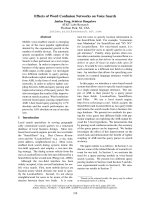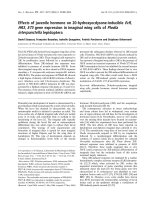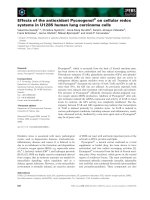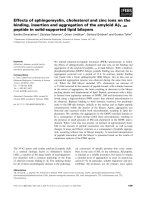Báo cáo khoa học: "Effects of drought on the induced defence reaction of Scots pine to bark beetle-associated fungi" ppsx
Bạn đang xem bản rút gọn của tài liệu. Xem và tải ngay bản đầy đủ của tài liệu tại đây (378.77 KB, 7 trang )
Note
Effects
of
drought
on
the
induced
defence
reaction
of
Scots
pine
to
bark
beetle-associated
fungi
L Croisé
F
Lieutier
INRA,
Station
de
Zoologie
Forestière,
Ardon,
45160
Olivet,
France
(Received
3
April
1992;
accepted
14
September
1992)
Summary —
Water
stress
was
imposed
on
Scots
pine
saplings
grown
in
a
greenhouse.
Predawn
leaf
water
potential
(ψ
wD
)
was
monitored
regularly
while
carbohydrate
reserves
were
quantified
in
the
phloem,
xylem
and
shoots.
Trees
were
inoculated
in
the
bole
with
a
bark
beetle-associated
fun-
gus
at
4
different
periods
of
the
year;
the
induced
defence
reaction
was
quantified
2-3
wk
later
by
its
length
and
the
total
amount
of
resin.
A
decrease
in
the
induced
reaction
(length
and
resin
quantity)
was
observed
in
the
most
severely
stressed
trees.
However,
no
clear
relationship
could
be
estab-
lished
between
the
concentration
of
carbohydrates
(soluble
or
hydrolysable)
and
the
intensity
of
the
defence
reaction.
pinus
sylvestris
/
phytopathogenic
fungus
/
induced
defence
reaction
/
water
stress
/
pre-
dawn
leaf
water
potential
/ carbohydrate
reserve
Résumé —
Action
d’un
stress
hydrique
sur
la
réaction
de
défense
induite
du
pin
sylvestre
contre
des
champignons
issus
d’insectes
Scolytides.
Un
stress
hydrique
a
été
appliqué
en
serre
sur
des
pins
sylvestres
de
6
ans.
Des
champignons
phytopathogènes
préalablement
isolés
d’in-
sectes
Scolytides
ont
été
directement
inoculés
dans
le
liber
de
ces
arbres
afin
de
préciser
l’effet
de
la
contrainte
hydrique
sur
les
caractéristiques
de
la
réaction
locale
de
défense
(longueur
et
quantité
totale
de
résine).
L’état
hydrique
des
arbres
a
été
suivi
régulièrement
par
des
mesures
du
potentiel
hydrique
de
base
au
niveau
des
aiguilles
(ψ
wD).
Les
réserves
glucidiques
de
l’arbre
ont
été
dosées
dans
le
liber,
l’aubier
et
les
pousses
au
moment
des
inoculations.
Quatre
séries
d’expérience
ont
ainsi
été
réalisées
sur
les
mêmes
arbres,
de
mai
à
octobre
1989.
Pour
des
potentiels
de
base
allant
jusqu’à
-2
MPa,
ψ
wD
est
systématiquement
et
négativement
corrélé
avec
les
caractéristiques
de
la
réaction
de
défense
dans
chaque
série
d’expériences
(tableau
I).
Aucune
différence
concernant
la
teneur
en
glucides
n’apparaît
entre
les
arbres
stressés
et
les
témoins
dans
les
différents
comparti-
ments
considérés
(tableau
II).
Pinus
sylvestris / champignon
phytopathogène / réaction
de
défense
induite / stress
hydrique
/ potentiel
hydrique
foliaire
/ réserve
glucidique
INTRODUCTION
In
coniferous
trees
attacked
by
bark
beetles,
an
induced
reaction
visible
as a
resinous
impregnation
of
the
tissues
sur-
rounding
the
point
of
aggression
plays
a
determining
role
in
the
resistance
of
the
tree.
In
the
majority
of
cases,
the
reac-
tion
appears
to
be
induced,
or
at
least
considerably
amplified
by
the
presence
of
fungi
introduced
by
the
insect
(Berry-
man,
1972;
Christiansen
and
Horntvedt,
1983;
Raffa
and
Berryman,
1983;
Cook
and
Hain,
1986;
Christiansen
et al,
1987;
Lieutier
et al,
1988;
Lieutier,
1992).
The
success
or
failure
of
each
attack
de-
pends
on
the
outcome
of
the
struggle
be-
tween
the
bark
beetle
and
its
associated
fungi,
and
the
intensity
of
the
defence
re-
action
at
the
site
of
attack.
The
defen-
sive
ab,lity
of
a
tree
can
be
represented
by
the
attack
density
threshold
above
which
the
tree
is
no
longer
able
to
resist.
Since
the
production
of
induced
resin
is
costly
in
terms
of
energy
(Croteau
and
Loomis,
1975)
this
threshold
should
be
higher
the
lower
the
energy
mobilized
in
each
reaction.
The
attack
density
thresh-
old
appears
to
depend
on
the
vigor
of
the
tree
at
the
time
of
attack
(Berrymn,
1978;
Waring
and
Pitman,
1983;
Mulock
and
Christiansen,
1986).
Tree
vigor
is
conditioned
by
several
factors
among
which
climatic
factors
are
probably
deter-
mining.
A
number
of
authors
have
report-
ed
that
the
worst
bark
beetle
damage
in
conifer
forests
are
often
preceded
by
a
major
period
of
drought
(Christiansen
et
al,
1987;
Mattson
and
Haack,
1987;
and
references
therein).
Thus,
there
is
prob-
ably
a
relationship
between
the
water
status
of
a
tree,
the
attack
density
threshold,
and
the
characteristics
of
the
induced
reaction.
The
present
paper
in-
vestigates
the
relationships
between
tree
water
status
and
the
characteristics
of
the
induced
reaction.
MATERIALS
AND
METHODS
Water
stress
treatments
Fourteen
6-yr-old
(2.20
rri
high)
Scots
pines
grown
in
pots
were
divided
into
2
groups
and
watered
with
a
drop-by-drop
system.
Group
A
(control)
received
=
20
I
of
water
per
wk
per
tree,
while
group
B
was
subjected
to
water
stress
be-
ginning
on
May
12,
Julian
d
133.
After
this
date,
the
group
B
trees
received
3
I
of
water
per
wk
per
tree
until
June
16,
Julian
d
168,
9
I
from
June
16-July
3,
Julian
d
185,
6
I
from
July
3-
August
7,
Julian
d
220,
and
again
3
I per
wk
per
tree
thereafter.
Tree
water
status
Predawn
leaf
water
potential
(ψ
wD
)
was
meas-
ured
with
the
pressure
chamber
technique
(Scholander
et
al,
1965).
The
measurements
were
carried
out
on
2
pairs
of
needles
per
tree
from
the
current
year
shoots.
Needles
were
col-
lected
between
4:30
and
5:30
am
GMT
every
10-20
d.
Stress
intensity
at
a
given
date
of inoc-
ulation
was
evaluated
as
the
average
(ψ
wD
) of
measurements
made
on
the
same
tree
between
6 d
prior
to
and
16
d
after
inoculation.
Tree
defence
reactions
The
reactions
were
induced
with
artificial
inocu-
lations
of
Ophiostoma
brunneo-ciliatum
(Math-
K)
or
Leptographium
wingfieldii
(Morelet),
2
As-
comycete
fungi
previously
isolated
from
the
pine
bark
beetle
Ips
sexdentatus
Boern
and
Tomicus
piniperda
L
respectively
(Lieutier
et
al,
1989).
These
fungi
had
been
cultivated
and
purified
as
monospore
cultures
on
a
malt-agar
medium.
Five-mm
diameter
agar
implants
from
3-wk-old
cultures
were
introduced
into
the
trees
at
the
cambium
level
accoring
to
a
technique
derived
from
Wright
(1933)
and
which
has
been
previ-
ously
described
(Lieutier
et al,
1989).
One
inocu-
lation
was
performed
per
tree
on
May
22
(Julian
d
143), July
11
(Julian
d 193),
1989
with
O brun-
neo-ciliatum,
August
16
(Julian
d
229),
and
Sep-
tember
21
1989
(Julian
d
265)
with
L
wingfieldii.
Two
or
3
wk
after
inoculation,
the
bark
around
the
inoculation
points
was
pulled
away
to
ex-
pose
the
reaction
zone
of
the
phloem.
This
reac-
tion
zone
was
then
measured
(length)
and
cut
into
samples
which
were
immediately
placed
into
dry
ice
under
a
nitrogen
atmosphere.
These
samples
were
kept
at
-35
°C
until
analysis
for
total
resin
content.
Samples
of
non-inoculated
phloem,
as
well
as
sapwood
and
shoot
axes
(phloem
and
xylem)
of
new
growth
were
taken
on
December
21,
1988,
March
20,
1989,
and
on
the
days
of
inoculation;
they
were
frozen,
and
stored
in
the
laboratory
at
-35
°C
before
analy-
sis for
their
carbohydrate
content.
Non-
inoculated
phloem
and
sapwood
were
sampled
near
the
inoculation
point,
and
the
shoots
at
the
end
of
lateral
branches
directly
above
the inocu-
lation
point.
Analyses
The
resin
content
in
the
induced
reaction
zones
was
measured
according
to
a
previously
de-
scribed
method
(Lieutier
et
al,
1989).
The
re-
sults
were
expressed
as
the
total
quantity
of
res-
in
present
in
fresh
whole
reaction
zones.
Carbohydrates,
separated
into
a
soluble
and
hy-
drolysable
fraction,
were
measured
and
ex-
pressed
in
terms
of
glucose
equivalents
by
the
anthrone
colorimetric
method
used
by
Mokrash
(1954)
and
modified
by
Sauvard
(1988).
RESULTS
Water
status
of
trees
Watering
of
control
trees
kept
their
pre-
dawn
leaf
water
potential
at
relative
stable
levels
between
-0.3
and
-0.6
MPa
during
the
whole
experiment
(fig 1).
In
stressed
trees,
2
phases
can
be
distinguished.
The
first
coincides
with
the
first
inoculations
and
was
characterized
by
a
strong
water
deficit
(ψ
wD
down
to
-2.1
MPa).
The
sec-
ond,
where
ψ
wD
was
between
-0.55
and
-1.2
MPa,
began
at
Julian
d
182
and
con-
tinued
until
the
end
of
the
expriment.
Defence
reactions
The
defence
reaction
zone
of
the
stressed
trees
was
only
once
significantly
shorter
than
that
of
the
control
trees
(May;
15
±
4.7
mm
for
the
control
and
5.6
±
3.0
mm
for
the
stressed
trees).
Total
quantity
of
resin
in
the
defence
reaction
zone
never
differed
significantly
between
the
2
categories
of
trees.
However,
the
correlations
between
|ψ
wD
|
and
the
characteristics
of
the
de-
fence
reactions
(length
and
resin
quantity)
were
constantly
negative
(table
I).
Three
of
them
(2
for
the
length
and
1
for
resin
quan-
tity)
differed
significantly
(P
≤
0.05)
from
zero
and
another
(concerning
resin
quanti-
ty)
was
almost
significant
(P =
0.058).
Carbohydrate
reserves
(table
II)
After
statistical
analyses,
phloem,
xylem
and
shoots
showed
no
significant
differ-
ences
between
the
carbohydrate
(soluble
or
hydrolysable)
content
of
stressed
trees
and
that
of
control
trees.
Otherwise,
the
carbohydrate
content
of
each
compartment
did
not
vary very
much
over
time.
DISCUSSION
Since
the
trees
recovered
from
all
inocula-
tions
it
may
be
hypothesized
that
the
length
of
the
reaction
zone
was
proportion-
al
to
the
duration
of
the
struggle
between
the
tree
and
its
aggressor,
and
that
total
quantity
of
induced
resin
included
in
the
re-
action
zone
was
proportional
to
the
quanti-
ty
of
energy
invested
by
the
tree
in
its
de-
fence.
Under
these
conditions,
our
results
suggest
that
the
aggressors
were
arrested
more
rapidly
and
that
the
quantity
of
ener-
gy
invested
for
that
purpose
was
lower
in
the
stressed
trees.
We
cannot
a
priori
discard
a
direct
ef-
fect
of
stress
on
the
fungus.
However,
phy-
topathogenic
fungi
are
generally
more
tol-
erant
than
plants
to
water
deficits
(Pinon,
1986;
and
references
therein).
According
to
Cook
and
Papendick
(1972;
in
Pinon,
1986), fungal
growth
is
still
possible
for
wa-
ter
potentials
as
low
as
-3
to
-5
MPa.
Sometimes,
water
stress
can
even
pro-
voke
stimulation
of
that
growth,
as
ob-
served
by
Bagga
and
Smally
(1967;
in
Pin-
on,
1986)
for
the
aspen
canker
in
in
vitro
cultures.
Under
these
conditions
it
seems
unlikely
that
the
decrease
in
the
induced
reaction
in
our
experiment
was
due
to
a
decrease
in
fungal
vitality.
Some
data
on
response
regarding
the
relationships
between
water
stress
and
the
induced
defence
reaction
have
been
ob-
tained.
A
constant
negative
correlation
was
observed
between
the
characteristics
of
the
defence
reaction
and
the
predawn
leaf
water
potential.
Thus,
it
seemed
that
when
water
stress
increased,
both
reaction
length
and
quantity
of
induced
resin
in
that
reaction
decreased.
The
decrease
in
the
amount
of
induced
resin
is
in
agreement
with
the
decrease
observed
by
Lorio
(1986)
for
constitutive
resin
in
Pinus
taeda
during
a
period
of
severe
drought.
It
is
also
in
agreement
with
the
findings
of
Paine
and
Stephen
(1987)
who
noticed
for
the
same
species
a
less
important
induced
re-
action
in
the
dominated
trees
than
in
the
dominant
trees.
Stephen
et
al
(1983)
claimed
that
an
important
defence
reaction
would
correspond
to
trees
resistant
to
bark
beetle
attacks.
In
Norway
spruce,
Chris-
tiansen
et
al
(1987)
observed
that
marked
reactions
could
develop
in
weak
trees
close
to
death.
This
observation
seems
to
be
in
opposition
to
our
present
results;
however
the
situation
described
by
these
authors
was
obtained
with
an
inoculation
density
above
the
lethal
threshold;
in
these
conditions,
the
fungus
extended
to
the
whole
phloem.
It
was
very
different
from
our
situation
with
isolated
inoculations
which
were
always
contained
by
the
tree
response.
Nevertheless,
Lorio
(personal
communication)
observed
an
increase
in
constitutive
resins
during
a
limited
period
of
drought,
and
Lieutier
and
Ferrell
(1988)
reported
an
increase
of
induced
reaction
in
Scots
pine
when
tree
growth
efficiency
de-
creased.
Our
results
did
not
demonstrate
any
modification
in
the
amount
of
stored
carbo-
hydrates
in
the
shoots,
phloem
and
xylem
in
response
to
water
stress
(table
II).
Pos-
sibly
a
longer
or
a
more
intense
water
stress
would
have
been
necessary
to
in-
duce
such
modifications.
Indeed,
Grieu
et
al
(1988)
reported
an
increase
of
the
solu-
ble
carbohydrates
in
Douglas
fir
needles
for
strong
water
stress
(ψ
wD
=
-1.6
MPa).
However,
these
authors
observed
only
weak
variations
of
these
compounds
in
the
needles
and
in
the
roots
of
the
same
tree
and
in
those
of
Pseudotsuga
macrocarpa
and
Cedrus
atlantica,
with
a
leaf
predawn
water
potential
below
-2 MPa.
It
is
there-
fore
difficult
to
consider
the
observed
varia-
tions
in
the
tree
defence
reactions
to
be
a
consequence
of
variation
of
stored
carbo-
hydrates.
These
conclusions
agree
with
the
re-
sults
of
Christiansen
and
Ericsson
(1986)
who
reported
that
the
level
of
stored
starch
was
not
correlated
with
Picea
abies
resis-
tance
to
infection
by
Ophiostoma
poloni-
cum.
Owing
to
the
fact
that
resin
synthesis
is
costly
for
the
tree
(Croteau
and
Loomis,
1975),
Christiansen
and
Ericsson
(1986)
have
suggested
that
the
flow
of
assimilates
might
be
the
main
source
of
energy
for
the
development
of
the
defence
reactions.
Stored
starch
might
thus
be
a
complemen-
tary
source
of
energy
when
the
current
flow
is
not
sufficient.
Otherwise,
the
study
of
resin
biosynthesis
in
Pinus
pinaster
(Bernard-Dagan,
1988)
suggested
that
the
ascending
flux
of
soluble
carbohydrates
from
roots
might
also
be
an
important
en-
ergy
source
for
the
induced
reactions.
Ac-
cording
to
the
same
authors,
the
possible
catabolism
of
the
heartwood
resin
might
lo-
cally
participate
in
the
defence
mecha-
nisms
at
the
beginning
of
the
annual
growth
activity.
ACKNOWLEDGMENTS
The
authors
are
grateful
to
E
Christiansen
(NISK,
Norway)
and
E
Dreyer
(INRA,
France)
for
their
comments
on
the
manuscript.
They
also
thank
J
Garcia
and
P
Romary
for
their
tech-
nical help.
REFERENCES
Bernard-Dagan
C
(1988)
Les
substances
de
ré-
serve
du
Pin
maritime:
rôle
éventuel
des
métabolites
secondaires.
Bull
Soc
Bot
Fr Ac-
tual Bot
135,
25-40
Berryman
AA
(1972)
Resistance
of
conifers
to
invasion
by
bark
beetle-fungus
associations.
Bio-Science
22, 599-601
Berryman
AA
(1978)
A
synoptic
model
of
the
Lodgepole
pine/Mountain
pine
beetle
interac-
tion
and
its
potential
application
in
forest
management.
In:
Theory
and
Practice
of
Mountain
Pine
Beetle
Managment
in
Lodge-
pole
Pine
Forests
(Berryman
AA,
Amman
GD,
Stark
RW,
Kibbee
DL,
eds)
College
For
Res,
Univ
Idaho,
Moscow,
ID,
98-105
Christiansen
E,
Horntvedt
R
(1983)
Combined
Ips/Ceratocystis
attack
on
Norway
spruce,
and
defensive
mechanisms
of
the
trees.
Z Angew Entomol 96, 110-118
Christiansen
E,
Ericsson
A
(1986)
Starch
re-
serves
in
Picea
abies
in
relation
to
defence
reaction
against
a
bark
beetle
transmitted
blue-stain
fungus,
Ceratocystis
polonica.
Can
J
For
Res
16,
78-83
Christiansen
E,
Waring
RH,
Berryman
AA
(1987)
Resistance
of
conifers
to
bark
beetle
attack:
searching
for
general
relationships.
For
Ecol
Manage
22, 89-106
Cook
SP,
Hain
FP
(1986)
Defensive
mecha-
nisms
of
Loblolly
and
Shortleaf
pine
against
attack
by
southern
pine
beetle,
Dendrocto-
nus
frontalis
Zimmerman,
and
its
fungal
as-
sociate,
Ceratocystis
minor
(Hedgecock)
Hunt.
J
Chem
Ecol 12, 1397-1406
Croteau
R,
Loomis
WD
(1975) Biosynthesis
and
metabolism
of
monoterpenes.
Int
Flavours
Food
Addit
6,
292-296
Grieu
P,
Aussenac
G,
Larher
F
(1988)
Séche-
resse
édaphique
et
concentrations
en
quelques
solutés
organiques
des
tissus
foli-
aires
et
racinaires
de
trois
espèces
de
co-
nifères:
Cedrus
atlantica
Manetti,
Pseudotsu-
ga
macrocarpa
(Torr)
Mayr,
Pseudotsuga
menziesii
(Mirb)
Franco.
Ann
Sci
For
45,
311-322
Lieutier
F
(1992)
Induced
defence
reaction
of
conifers
to
bark
beetles
and
their
associated
Ophiostoma.
In:
Ceratocystis
and
Ophiosto-
ma:
Toxonomy,
Biology
and
Pathogenicity
(Wingfield
MJ,
Seifert
KA,
Webber
JF,
eds)
Am
Phytopathol
Soc
Press,
206-215
Lieutier
F,
Ferrell
GT
(1988)
Relationships
be-
tween
indexes
of
tree
vigour
and
the
induced
defense
reaction
of
Scots
pine
to
a
fungus
associated
with
Ips
sexdentatus
(Coleoptera:
Scolytidae).
In:
Integrated
Control
of
Scolytid
Bark
Beetles
(Payne
TL,
Saarenmaa
H,
eds)
Virginia
Polytechnic
Inst
and
State
Univ,
Blacksburg, VI,
163-178
Lieutier
F,
Yart
A,
Garcia
J,
Poupinel
B,
Levieux
J
(1988)
Do
fungi
influence
the
establishment
of
bark
beetles
in
Scots
pine?
In:
Mechanisms
of
Woody
Plant
Defenses
Against
Insects;
Search
for
Pattern
(Mattson
WJ,
Levieux
J,
Bernard-
Dagan
C,
eds)
Springer
Verlag,
321-331
Lieutier
F,
Yart
A,
Garcia
J,
Ham
MC,
Morelet
M,
Levieux
J
(1989)
Champignons
phytopa-
thogènes
associés
à
deux
coléoptères
Scoly-
tidae
du
Pin
sylvestre
(Pinus
sylvestris
L)
et
étude
préliminaire
de
leur
agressivité
envers
l’hôte.
Ann
Sci
For 46,
201-216
Lorio
PL
Jr
(1986)
Growth-differentiation
bal-
ance:
a
basis
for
understanding
Southern
pine
beetle-tree
interaction.
For
Ecol
Man-
age
14,
259-273
Mattson
WJ,
Haack
RA
(1987)
The
role
of
drought
in
outbreaks
of
plant-eating
insects.
Bio
Science
37, 110-118
Mokrash
LC
(1954)
Analysis
of
hexose
phos-
phates
and
sugar
mixtures
with
the
anthrone
reagent.
J
Biol
Chem
208,
55-59
Mulock
P,
Christiansen
E
(1986)
The
threshold
of
successful
attack
by
Ips
typographus
on
Picea
abies:
a
field
experiment.
For
Ecol
Manage
14, 125-132
Paine
TD,
Stephen
FM
(1987)
Influence
of
tree
stress
and
site
quality
on
the
induced
de-
fense
system
of
Loblolly
pine.
Can
J
For
Res
17, 569-571
Pinon
J
(1986)
Les
maladies
de
faiblesse
en
plantation.
Rev
For
Fr
38,
324-330
Raffa
KF,
Berryman
AA
(1983)
Physiological
as-
pects
of
Lodgepole
pine
wound
responses
to
a
fungal
symbiont
of
the
mountain
pine
bee-
tle,
Dendroctonus
ponderosae
(Coleoptera:
Scolytidae).
Can
Entomol 115,
723-731
Sauvard
D
(1988)
Capacité
de
multiplication
de
Tomicus
piniperda
L
(Coleoptera:
Scolytidae)
selon
la
densité
d’attaque
et
diverses
carac-
téristiques
de
l’arbre.
Thèse
Doctorat,
Univer-
sité
d’Orléans
La
Source,
130
p
Scholander
PF,
Hammel
HT,
Bradstreet
ED,
Hemmingsen
EA
(1965)
Sap
pressure
in
vas-
cular
plants.
Science
148,
339-346
Stephen
FM,
Paine
TD,
Lih
MP
(1983)
Under-
standing
bark
beetle/host
interactions:
a
means
for
improving
decision
strategies.
Z Ang
Entomol 96,
257-265
Waring
RH,
Pitman
GB
(1983)
Physiological
stress
in
Lodgepole
pine
as
a
precursor
for
Mountain
pine
beetle
attack.
Z
Ang
Entomol
96, 265-270
Wright
E
(1933)
A
cork-borer
method
for
inocu-
lating
trees.
Phytopathology 23,
487-488









